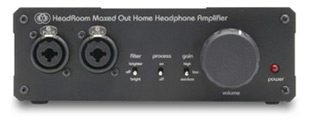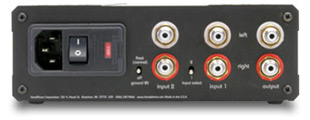
Front

Rear
|
Design
At 6.5" wide, 2.25" high, and 12" long, the
5.5-pound Maxed Out Home is more like a small power amplifier than a typical headphone
amp. Inside, a dual-mono power supply provides 15V to two of HeadRoom’s reference
electronics modules. All parts are of the high quality you’d expect for the price,
including Cardas input connectors, Neutrik headphone jacks, and a Nobel volume-control
potentiometer.
The Maxed Out Home is available in two versions. One
configuration has two inputs, the other a loop output that allows the input signal to pass
through. The loop version is useful for tapping into audio that’s passing through the
amp -- for example, if you wanted to add a headphone output to your TV or CD player. I
tried only the dual-input version because it’s more suitable for use as a preamp, and
so can’t comment on the sound quality of the loop.
Because the Maxed Out Home is intended for home use, all of
its inputs are via RCA connectors, and the two headphone outputs have full-size 0.25"
jacks that also accept XLR headphone connectors. Most portable devices use mini-jack
inputs or outputs, and you’ll need an adapter to plug them in (some headphones ship
with them). The power supply is fed with a standard IEC power connector, compatible with
an upgraded aftermarket power cable if desired. The On/Off switch is on the rear panel,
with the inputs and outputs. The dual-input model also has a switch on the rear to choose
between inputs; on the loop-out version, that switch instead enables or disables the loop.
Because it’s on the rear, this switch can be difficult to reach if the Home is placed
in an equipment rack, but I was able to do it after a little practice.
The rear panel includes a ground-lift switch with two
settings: Float and Off. The manual recommends this be turned Off when the Home is used as
a preamp, and that it remain in the Float position otherwise. In my testing, I found it
was worth checking both possibilities no matter how I was using the Home -- in the wrong
setting, the amp was noisier and sometimes hummed. Obviously, whichever setting is quieter
is the right one. You might find that you need to toggle this if you switch between
headphones plugged into the front and the preamp outputs on the rear; again, depending on
the installation location, it can be slightly inconvenient to access this rear switch.
There is a dizzying array of controls. The first
front-panel setting worth checking out is Gain, which has High, Medium, and Low settings.
This controls how loud the Maxed Out Home is overall, and interacts with the main volume
control. I found that the Home sounded best at the High setting, and had a slight loss of
authority at the other settings. However, if you’re using the unit as a preamp, the
Medium and Low settings should be enormously beneficial in getting a useful range of
volume out of the knob. With my 200Wpc amplifier and sensitive speakers, Low was
definitely the right setting if I wanted fine control of volume level. Make sure you turn
the volume down before switching the gain control, to avoid loud surprises or blown
equipment.
Next is the switch that controls whether the HeadRoom
Process is engaged. The Process can improve the sense of space from a stereo recording,
but with a tonal shift toward the bass. To compensate for that shift, HeadRoom provides a
Filter switch with three settings: Off, Bright, and Brighter. These labels lived up to
their names, making the treble more prominent, and worked even when the HeadRoom Process
was turned off. This made the sound of the Home tuneable to an extent; it could greatly
improve some equipment combinations.
Usually, only one of the Filter settings will sound right,
and the others so exaggerated as to make one wonder why HeadRoom even included them. But
switch out some of your other components, and surprise! Those other settings are
essential. For example, I had a system with a Pioneer DV-525 DVD player, the Maxed Out
Home, and Sennheiser HD 580 headphones. With the Process on, changing the Filter
setting to Bright was essential, while Brighter seemed extreme. But when I switched to my
Panasonic SL-S320 portable CD player, suddenly the Brighter setting was the perfect one.
Performance
I first used the Maxed Out Home as a preamplifier. While I
haven’t used many analog preamps lately, I pulled my Rotel RSP-960AX out of storage
and hooked it up to drive my Warner Imaging Endangered Species power amplifier. The Rotel,
a fairly simple model from 1996, had excellent sound for its $600 price. I was expecting a
fairly even matchup with the Home, but boy, was I wrong -- the HeadRoom was enormously
better. It made the Rotel sound very dated, even distinctly rolled-off in the highs.
The Maxed Out Home did a remarkable job of cleanly passing
through the full sonic palettes of SACDs. With the new SACD of Pink Floyd’s The
Dark Side of the Moon [Capitol CDP 5 82136 2], the bass on the opening heartbeat
sounded very taut through the HeadRoom used as a preamp, but sounded smeared in comparison
through the Rotel RSP-960AX. Oddly, the Rotel didn’t sound as smooth in the
mid-treble as the HeadRoom, even though it obviously had less top-octave energy.
I switched to another fine SACD, The Police’s Synchronicity
[A&M 069 493 606-2]. "Wrapped Around My Finger" features a hard percussion
slap throughout, and on many of those slaps, the echo and sonic space around the
percussion have depth that I’ve never heard from any CD. But when I passed the SACD
analog signal through the Rotel preamp, the magic was gone. The Denon AVR-3801 receiver I
normally use for home theater can also be used as an analog preamp when switched to its
Direct mode, and had a sonic character midway between the Rotel and the Maxed Out Home
(used as a preamp). The Denon did a solid job of playing difficult selections such as The
Police track, while never quite matching the Home’s high-frequency extension.
But for all its merits, one thing I couldn’t attribute
to the Maxed Out Home was a "liquid" midrange, or anything else suggesting a
"tube-like" sound. The HeadRoom was a hardcore solid-state preamp with a
death-grip on the bass and a mercilessly unforgiving top end.
Driving headphones directly, the Maxed Out Home seemed more
forgiving because its amplifier was so clean. There was still the extreme control of bass
notes this model excelled at, and the treble was plenty revealing, but I’d never
characterize it as "bright" -- unless I wanted it to be and adjusted the Filter
switch accordingly. With most headphones, the Maxed Out Home removed all the amplifier
constraints that normally limit my listening -- I was free to play music at whatever
volume I liked and still hear it cleanly reproduced. This was similar to how I feel when
listening to a power amplifier whose capabilities enormously exceed the power demands of
the speakers, which gives the dynamics a quality of effortlessness.
There were exceptions. Even the Maxed Out Home didn’t
have enough oomph to fully drive the very demanding AKG K501 headphones -- the
volume never quite reached the "loud" level, even with the gain and volume all
the way up. But for anything short of the most difficult phones on the market, the Home
delivered reference-quality amplification, letting me hear what the phones were really
doing. The highlights of the sound were always great dynamics, crisp transients, and total
control of low frequencies. But if you prefer a lusher kind of sound, you’ll likely
be better suited by something tubed.
Individual sounds varied as I switched headphones, and
tracking all those combinations would take its own review. Some phones obviously worked
better than others, and usually it was the more expensive ones, aimed at home-only use,
that benefited the most from the Maxed Out Home. Sennheiser’s popular HD 580 are
reasonably rugged phones that work OK on the road, even using HeadRoom’s AirHead
amplifier. But the much more expensive HD 600s were the obvious choice with the Home,
when I was home and the phones’ fragile metal frames were safe from damage.
HeadRoom’s less expensive amps really don’t let you appreciate the subtle
improvements the HD 600s offer over the HD 580s -- if you’re using an
amplifier as good as the Maxed Out Home, you want to match it with similarly high-end
headphones. Budget favorites such as the Grado SR60s might actually work better with less
expensive amplifiers than the Home -- the amp’s powers of resolution made the flaws
of the inexpensive Grados really stick out.
The thing that impressed me most about the Maxed Out Home
was not how it sounded with any particular component, but that its sound was so adjustable
that I could make many equipment pairings sound right. With two ground settings,
two Process settings, three Filter settings, and three Gain settings, there are numerous
ways you can configure the Home. And while I didn’t try every permutation of every
combination of controls, I did find every one of those controls essential. It took a bit
of fiddling to dial in the sound I wanted whenever I switched headphones or sources, but
so much adjustability was available that I always ended up satisfied.
Conclusions
HeadRoom’s Maxed Out Home is expensive, but it
features a five-year warranty, and every HeadRoom product has a 30-day satisfaction
guarantee that permits return of the unit if you’re not happy. Part of my attraction
to the Home is that it’s a perfect reviewer’s tool that can be made compatible
with many different equipment setups. You might find that, for your particular headphone
needs, you can be perfectly satisfied with something much less expensive. But if you were
also thinking about purchasing a solid-state stereo preamp with two inputs, the Maxed Out
Home might suddenly seem a more justifiable purchase. It’s spoiled me.
The impression I get from current HeadRoom products is one
of mature designs that have evolved through many rounds of feedback from demanding
customers. The HeadRoom Maxed Out Home has considerably increased the level of what I
expect from a high-quality headphone amplifier. I highly recommend you audition one.
Price of equipment reviewed
|